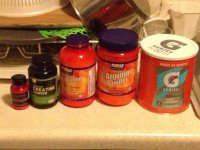I like the 10g of glutamine going to have to start using this

I originally started using a large dose of glutamine for instestinal health, but when I upped it, I noticed my recovery got better, so I stuck with it.
Here is why I buy the Glutamine AKG:
Liu, Y., R. Lange, et al. (2012). "Improved training tolerance by supplementation with alpha-Keto acids in untrained young adults: a randomized, double blind, placebo-controlled trial." Journal of the International Society of Sports Nutrition 9(1): 37.
BACKGROUND: Exercise causes a variety of physiological and metabolic changes that can in turn reduce exercise tolerance. One of the potential mechanisms responsible for fatigue is "exercise-induced hyperammonemia". Previous studies have shown that supplementation with amino acids can increase training tolerance. The alpha-keto acids are biochemical analogs of amino acids and can be converted to amino acids through transamination, thus reducing the cellular ammonia level. This double blind, placebo-controlled study was designed to investigate the effects of alpha-keto acid supplementation (KAS) on training tolerance, training effect, and stress-recovery state.
METHODS: Thirty-three untrained young male adults underwent four weeks of training (5 sessions/week; 30 minutes running at the individual anaerobic threshold followed by 3 x 3 minute sprints/each session). Throughout the 4 weeks of training and one week of recovery, subjects took ***alpha-ketoglutarate*** (AKG group, 0.2 g/kg/d, n = 9), branched-chain keto acids (BCKA group, 0.2 g/kg/d, n = 12) or isocaloric placebo (control group, n = 12) daily.
RESULTS: The 4th week training volume, maximum power output and muscle torque were higher in the AKG group (175 +/- 42 min, 412 +/- 49 Watts and 293 +/- 58 Newton meters, respectively, P<0.05) and the BCKA group (158 +/- 35, 390 +/- 29 and 273 +/- 47, P<0.05) than in the control group (92 +/- 70, 381 +/- 67 and 233 +/- 43). The general stress and emotional exhaustion as assessed by the rest-stress-questionnaire-sport after the 3rd week of training increased significantly in the control group (P<0.05), but not in the KAS groups.
CONCLUSIONS: Under KAS, subjects could bear a higher training volume and reach a higher power output and peak muscle torque, accompanied by a better stress-recovery-state. Thus, KAS improves exercise tolerance and training effects along with a better stress-recovery state. Whether the improved training tolerance by KAS is associated with effects on ammonia homeostasis requires further observation.


























